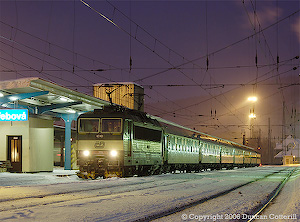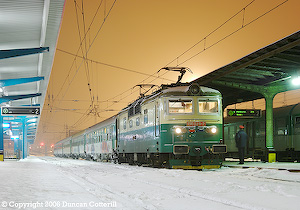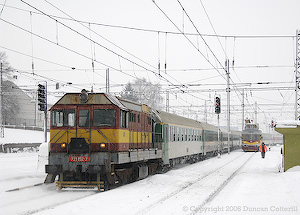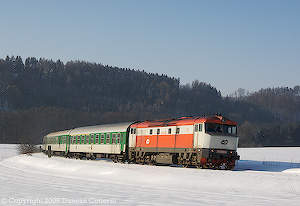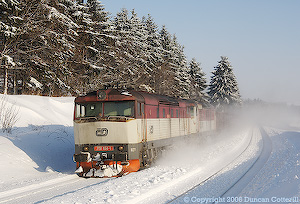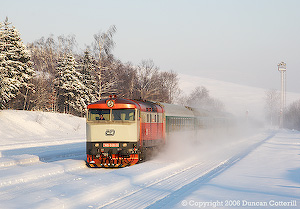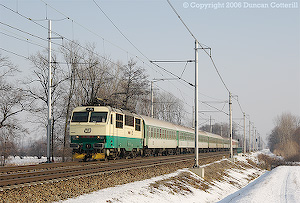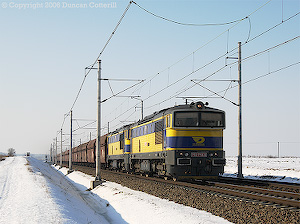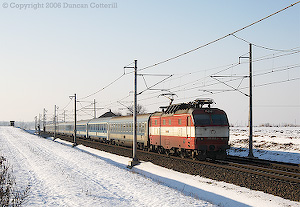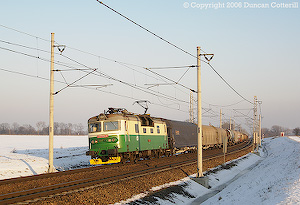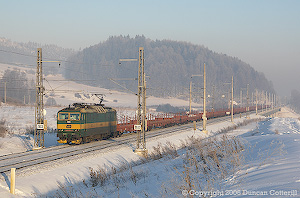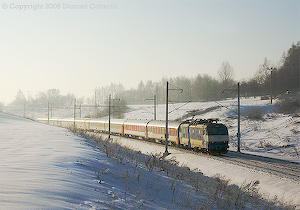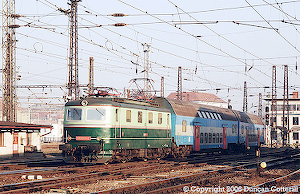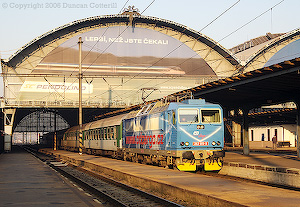Ceska Trebova in the Big Freeze
18 - 24 January 2006
Report by Duncan Cotterill
Introduction
This report describes a week long trip to photograph Czech diesels and electrics around Ceska Trebova in January 2006. This was my first real winter trip to the Czech Republic and I wasn’t really sure what to expect in terms of weather. To be on the safe side the full arctic gear was packed.
For the first few days my preparations looked like overkill. The weather was fairly typical of Central Europe in winter with overcast skies, temperatures around freezing and gentle snowfall most of the time. The conditions weren’t particularly harsh but weren’t at all rewarding for photography either.
When the temperatures plummeted to below -20°C towards the end of the trip, I was very glad of all the warm clothing.
Why Ceska Trebova?
Those not familiar with the railways of the Czech Republic probably won’t have heard of Ceska Trebova. It’s not a large town but it is an important railway junction where the electrified main lines from Praha (Prague) to the major centres of Brno and Ostrava diverge. As a result, there are marshalling yards, a shed, a locomotive works, plenty of trains worked by a variety of classes and a far better passenger service than would normally be expected for a town of that size. Another important factor for the photographer is that some of the best scenery on route from Praha to Ostrava lies between Chocen and Ceska Trebova.
Nearby, the line from Letohrad to Lichkov and on to Miedzylesie in Poland is one of the last diesel worked routes to carry relatively high levels of freight. As a bonus these trains are worked by the attractive class 751 diesels, not the utilitarian class 742s that are rapidly becoming the norm elsewhere. This route and the nearby line to Jesenik also see some diesel hauled passengers.
In short, there’s plenty of diesel and electric variety around Ceska Trebova and there are some excellent photographic locations in the area. It’s also relatively easy to travel further afield and much of the Czech Republic is within range of a day trip.
Lastly, but not least, there is a very comfortable hotel within easy walking distance of the station. The Hotel Korado in the town square provides an excellent base for a visit.
Main Line Passenger Action
As expected, Inter City and EuroCity services between Praha, Ostrava and points further east were largely in the hands of class 151 “Gorilla” electrics, CD’s fastest and most powerful passenger locos. 151 001/004/008/011/018/027 were all seen. Slovak class 350 electrics, the dual voltage equivalents of the 151s, worked most EuroCity services from Germany to Austria, Slovakia or Hungary via Praha and Brno. 350 002/004/012/013/014/019 were all seen. Fast trains from Praha to Prerov and beyond were worked by class 162s and those to Brno by 362s or 363s.
Local trains towards Pardubice, Kolin or Prerov generally had class 163 haulage while those towards Brno were worked by class 363s. There were a number of class 471 EMUs working between Pardubice and Kolin but these were easy to identify in the timetable by their Os9xxx numbers.
Class 130 electrics also worked a few services, notably Os5043 to Svitavy and Os4776 return on workdays and R971, R972, R974 and R975 between Ceska Trebova and Hradec Kralove every day. R970 and R973 on the Hradec Kralove route ran throughout with class 363s.
Class 150s have become fairly rare daytime visitors to Ceska Trebova over the past few years but they do still turn up on Fridays only extras from Praha and Sundays only returns, e.g R1502, R1503, R1504, R1505, R1540 and R1541.
Until the big freeze hit on Saturday night, virtually every train ran with the booked power and usually close to the booked time. After the temperatures dropped, reliability suffered considerably and delays of up to 6 hours were noted, particularly on overnight trains from eastern Slovakia. Generally trains from east of Prerov were more heavily delayed than those from Brno or Breclav. A number of trains booked for class 151s were observed with class 162s or 163s while several of those diagrammed for class 350s were worked by class 362s or 363s. How many of these were due to loco failures and how many could be accounted for by late running isn’t known. One surprise was that class 163s, with a maximum speed of 120 km/h, were used for substitute power on expresses in preference to the faster, more powerful and underutilised class 150s. 150 013 did appear on R705 on 23 January but that was the only occasion I saw one.
Pendoli - NO?
CD tried to introduce it’s class 680 “pendolino” tilting EMUs at the December timetable change. They were supposed to work a number of SuperCity services between Praha and Ostrava and a couple of EuroCity trains between Praha and Wien or Bratislava via Brno. The introduction was heavily publicised with huge posters everywhere, including covering the glass front of the overall roof at Praha hl.n.
Unfortunately for CD, it all seems to have gone horribly wrong. At the time of my visit, very few of these trains were actually being worked by the pendolino sets. And that was before the really cold weather! The vast majority of SC trains on the Ostrava route were being covered by class 162s on rakes of 6 conventional coaches. Similar sets with class 362 or 363 haulage covered trains on the Brno route.
Czech TV news seemed to feature the pendolino fiasco every evening including regular appearances by high ranking CD officials and occasionally by apologetic looking Alstom cannon fodder. It was all very reminiscent of BR’s attempt to introduce the APT on the London – Glasgow route more than 20 years ago.
Main Line Freight
There have been some significant changes in the main line freight scene recently. The class 181 and 182 Co-Co electrics which used to be the mainstay of freight traffic on the east – west main line have now lost all their diagrammed work, except for a handful of banking turns in the far east. Fortunately, they do still appear occasionally on PP (as required) workings.
The ubiquitous class 163s are now the most common freight power in the Ceska Trebova area but a significant number of trains are worked by class 130s, particularly west of Ceska Trebova. Usti nad Labem based class 122s and 123s now appear regularly as well. Freight in the Brno direction remains the preserve of the dual voltage class 363s.
Open access operators can be seen as well, particularly the coal trains of OKD Doprava with their double headed blue and yellow class 753.7 diesels. One train was seen triple headed by a pair of 753s and a class 182, all in OKD D colours.
What actually turned up at any given time bore little resemblence to the timetable so I won’t go into detail except to say that freight traffic was definitely heavier towards the end of the week with Monday and Tuesday fairly quiet.
Watch Out - There’s a Hector About
The class 720 and 721 “Hectors” date back to the late 1950s and early 1960s. In 2000, when I first started taking a serious interest in Czech diesels, they were getting very rare, so to see one at work in 2006 was a real surprise. To see what it was doing came as a real shock.
On Friday 20 January the overhead was being worked on at the east end of platforms 3 and 4 at Ceska Trebova and 721 152 was being used as station pilot in preference to the usual class 111 electric. It’s prime role seemed to be to release class 163s that had arrived on local trains but couldn’t run round due to the lack of juice. When EuroCity 279 arrived behind 350 014, the 721 buffered up to the back and shoved the train out of the station and back under the live wires. A 721 in action was special enough but to find one assisting a EuroCity train could not have been anticipated.
For me, one of the great attractions of the Czech rail scene is its ability to turn up something completely unexpected every now and again. This was one of those occasions.
Other Lines
Usti nad Orlici to Letohrad
Until Saturday morning 111 019 and 111 031 were working the two passenger diagrams on this line but by midday 130 021 had replaced 111 019 and was still in the diagram until Monday at least.
On two occasions, pairs of Letohrad class 751s were seen at Usti exchanging freights with electrics, something that normally happens at the other end of the line.
Letohrad – Lichkov – Hanusovice
This line was visited three times during the trip on 20, 21 and 22 January. The Jesenik passengers, R756 and R757 were worked by 749 260 on 20 Jan and 749 008 on the other days. The Poznan train, R250, wasn’t seen on 20 Jan but was worked by 749 256 and 749 011 respectively on the other days. The loco for the Poznan is booked to pilot the railcar on Os20043 (Letohrad – Miedzylesie) on Saturdays and Sundays but actually ran light engine some time afterwards on both occasions.
Freights between Letohrad and Miezylesie are still worked by pairs of 751s. Two pairs were seen in action, 751 080 + 751 104 and 751 137 + 751 176. Train times weren’t particularly close to those booked and running seemed to be more than a bit erratic. For instance on Sunday 22 Jan, 751 080 + 751 104 left Usti nad Orlici with a freight for Miedzylesie before 08:30 but it was 11:40 before they passed Vermerovice, the first station east of Letohrad. I assume that this was Rn44255 due away from Letohrad at 08:44 but why the 3 hour delay? In contrast, 751 137 + 751 176 arrived at Letohrad at 12:00 with either a late running Pn44256 due at 10:25 or a slightly early Pn47274 but then left again for Poland at 12:35, two hours before the next booked working.
The Stity pick up was worked by 742 186 on the Friday and 742 113 was on Snowplough duty at Dolni Lipka.
Hanusovice – Jesenik
On 20 January, I took R757 from Letohrad to Jesenik and R756 return with 749 260. 731 027 was working the pick ups around Hanusovice and 751 041 was on Mn81761 from Zabreh n M to Mikulovice. At Jesenik 749 265 was stabled on the stock for R924 and 749 246 was on snowplough duty at Lipova Lazne.
Class 831 railcars were still much in evidence on this line, 831 182 was seen on Os3608, 831 110 on Os3610, 831 233 on Os3609 and an unidentified example on Os3678.
Praha Area
The afternoon of 24 January was spent in the Praha area. At Masarykovo, 141 004 was seen on Os9649 from Kralupy, one of the few remaining passenger workings for the class. There were more class 451 EMUs and less class 471 EMUs around than expected so perhaps the 471s were suffering from the cold weather as well.
At hlavni nadrazi (main station) 363 015 was photographed in a new CD cargo livery.
The northern exit from Praha hl.n. is now reduced to the single track line via the tunnel. The route that used to drop down to join the Masarykovo line has been lifted. As a result, a number of trains are diverted via Vrsovice and the southern loop line to Bechovice. A number of other services, including all the (supposed) pendolinos and some EuroCity services now use Holesovice instead of hlavni nadrazi.
Snippets
On 18 January, 749 258 was seen at Pardubice on what was probably R786 to Liberec.
Conclusions
Although the weather was disappointing for the first four days, the last three were very rewarding with blue skies, clear light and snow on the ground. The low temperatures themselves weren’t really a major problem. On the Monday I was out by the lineside for around 7 hours without really feeling uncomfortably cold in spite of the temperature being below -20°C for the first hour or so. The trick was to wrap up well and keep moving.
The biggest difficulty was getting about. Roads and pavements were covered with an uneven layer of slippery ice which made walking anywhere difficult. Stray off the roads and you were into snow between six inches and two feet deep. To make it worse, there was a hard crust on top that wasn’t quite solid enough to support all your weight, so every step was a step up, followed by a crash back down again, often onto something uneven underneath. Falling over every few yards was almost inevitable. Managing to get up again wasn’t always so simple. Still, if getting decent photographs was easy, it wouldn’t be such a rewarding pastime.
Back on the rails, it was notable how the 162s and 163s held the service together while everything else was falling by the wayside. The extreme weather that killed the pendolinos and left the Gorillas struggling just couldn’t stop them. I hadn’t been a great fan of these rather boxy locos in the past but I can’t help respect their ability to keep going in very adverse conditions. The same respect applies to CD’s staff on the ground who worked solidly to keep the trains moving. It can’t be much fun spending your entire shift digging out one set of points after another in blizzard conditions but the job was done and done well. If only those who specified, designed and built the pendolinos had been as diligent.
As I said at the beginning, I didn’t really know what to expect from the Czech winter but now, having experienced some of the coldest weather for several years, I’d happily go back at the same time of year.
